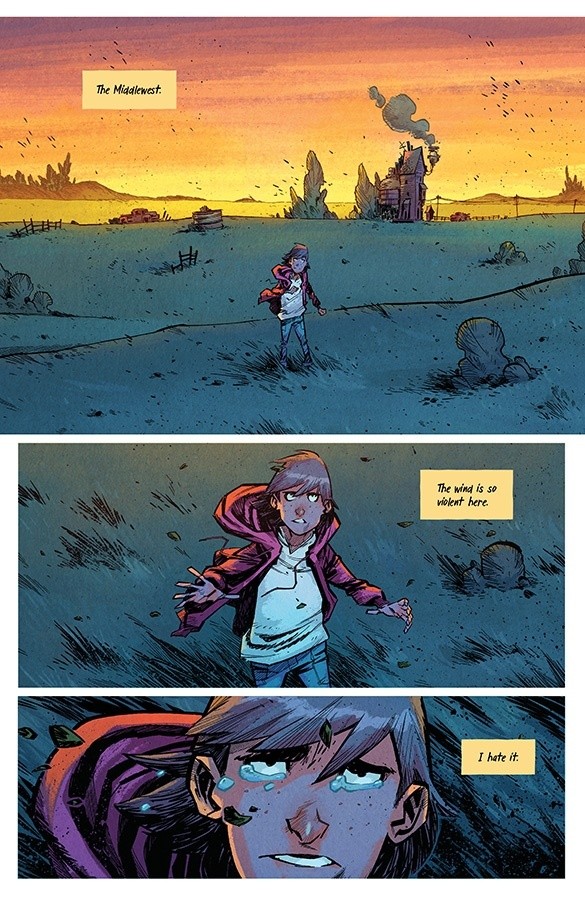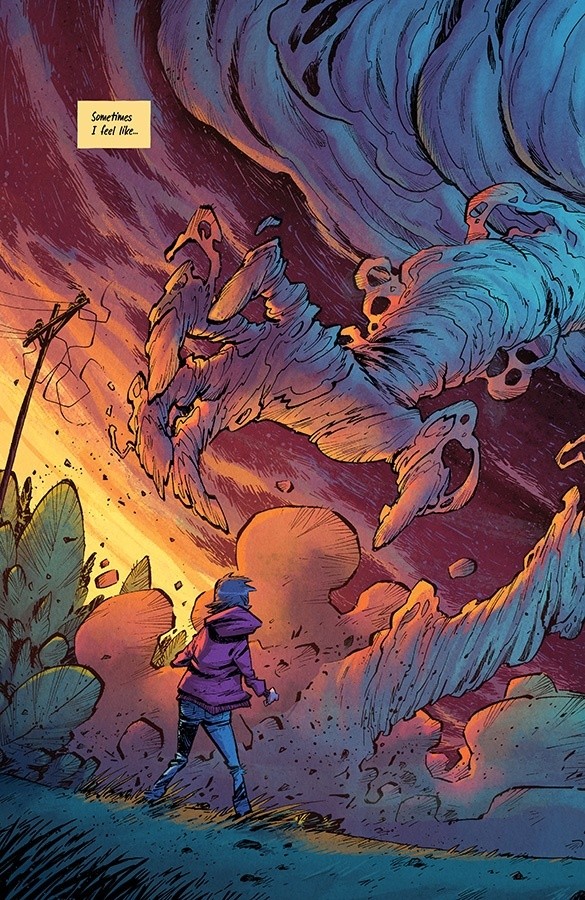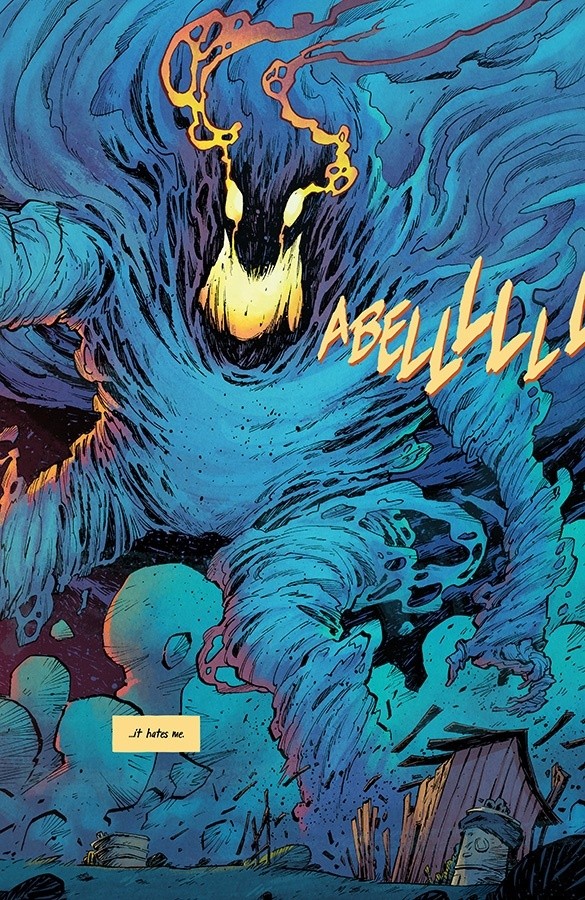With the rise of female-centered stories, there are signs that gender dynamics in comics are shifting. However, progress has not come quickly in the last 100 years of comics, sexism and machismo are still present in the pages of these publications. So when writer Skottie Young first came up with the idea to write Middlewest – the coming-of-age story of a boy and his relationship with his father – he didn’t think about the term toxic masculinity. He instead focused on writing a fantastical story set in the midwest. But through his words and the illustrations of Venezuelan artist Jorge Corona, he ended up creating a world that challenges toxic masculinity.
While Young pulled inspiration from many different sources – including his own life – for the story, he let Corona have full control of the artwork. As a result, we get stunning visuals of a world very similar to ours, except that magic and magicians dwell within their cornfields. Through the use of dynamic colors, and a little inspiration from his home, Venezuela, Corona takes the reader on an epic journey. The combination of Corona’s images and Young’s words captures the vulnerability of a prepubescent boy. It’s a type of vulnerability that has been historically stifled in media.

Middlewest centers on Able, a young boy who lives alone in a trailer with his dad. The comic opens with the strong wind, tornado-like, blowing in Able’s face. The wind hurts Able, and at times, he’s afraid it’ll blow him away. Able’s eyes fill with tears whenever he explains the pain his father inflicts on him. We see the emotional scars before Abel’s father ever lifts a finger on him. One day after a series of events, his father’s verbal abuse turns physical. His dad suddenly becomes the storm, causing Able to run away and set off on his adventure.
“You know I’m a fan of Oz and Labyrinth and all these coming of age stories where people are learning how to go off and be an adult,” Young, who came up with the concept in 2016, tells me. But in order to make this story a little different than just the average Wizard of Oz story, he wanted to insert some of his own personal experience growing up.
“The thing that’s bottled up stays bottled up for too long and the pressure builds, and it’s always released in the wrong ways.”
“It got me thinking to what I often call ’80s dads – there is no science behind that label. I started thinking about the kind of parenting of the ’80s, which I feel has a lot of bound up emotions from their parents. A lot of their parents came from World War II, WWI, and the Korean War, and you know, there’s a lot of ways that people deal with emotions. And especially how men deal with emotions, which is bottle it up. Then, the thing that’s bottled up stays bottled up for too long and the pressure builds, and it’s always released in the wrong ways.”
The comic started with a doodle of a boy and a farmer. The boy looks up to the farmer and says, “You don’t look like a wizard,” and the farmer responds, “What does a wizard look like?” From there, Young started thinking about a world where wizards don’t don robes a la Gandalf.
As he developed the story, he decided to tap an artist for the artwork, which is how Venezuelan comic artist Corona got involved. The two met when Young visited the Savannah College of Art and Design, where Corona was enrolled, as a guest lecturer. After seeing Corona’s early work, Young told him he wanted to keep in touch and hopefully work together in the future.
“You know, he was getting jobs at DC,” he says. “He was doing some stuff at Boom, and I just reached out to him and was like, ‘Hey would you ever be interested in doing some stuff with me? I’m thinking about doing some writing.’ I just knew he was so good, I wanted to work with him at some point. And then I thought man somebody who would work really, really well on this would be Jorge and I reached out, and you know he was working on his book called No. 1 With a Bullet at the time. I just sent him a script, and he really responded well to it. I met him while he was in college and five years later we have a business together.”

Corona is a rising star in the comic world. In 2018, he earned a nomination for the prestigious Eisner Award for the cover art he created for No. 1 With a Bullet. In 2015, Corona also won the Russ Manning Award.
Although the story is set in what looks like the Midwest, Corona was able to include illustrations reminiscent of the landscapes in Venezuela.
“When I was in college back home and a little bit of high school, I used to take [these] trips with my with my dad across the country… There are these flat parts of Venezuela that are just open fields and like those open fields, and it’s kind of like any other situation where you where you find yourself in the middle of nature with little to no connection to major cities or major major urban areas,” he says. “Those places are always full of legends, myths and folklore. You find yourself there and you’re trying to make explanations of the things that you think you see here. So that kind of hidden magic and that openness and vulnerability when you’re in places like that, I definitely brought some of that to Middlewest because even though even though aesthetically there’s some differences the environment itself has the same feeling of smallness you get when you’re surrounded by open spaces like that. That definitely translated from my experience back home and I tried to bring a little bit about to the to the books.”
Along the way, Young hoped to keep Corona engaged, and together, without realizing it, they unfurled a story that deals with the difficult topic of toxic masculinity – a subject each is familiar with, though in different ways. While Young saw it through the lens of ’80s TV dad, Jorge felt pressure about what it meant to be a man.
“I think when it comes to identity and gender politics, they are different in Venezuela than they are here in the States,” Corona tells me. “When it comes to specifically this story and the kind of toxic masculinity and the way it happens in Middlewest – at least in Venezuela where I grew up – the experience that I had was a little bit different.”
In his experience, fathers are accepting of sons so long as they adhere to gender-specific roles.
“That’s a little bit different from what we are doing with Middlewest, specifically because the idea of toxic masculinity and how it shapes Able’s family is not necessarily about the role gender-specific characteristics play,” he adds. “It’s about how it affects the upbringing and the relationships between grandfather, father, and son. And that is something that we are going to touch a little bit on the rest of the story.”

As Able is running from his father, the storm, he just barely escapes but not before his father touches his heart. The literal heartbreak is captured with Corona’s imagery and sets the tone that Able will forever be marked by his father – carrying with him a piece of his dad.
Middlewest is unique and powerful. By telling a truthful story of adventure Young and Corona have created a story that allows us to question some of the virulent behaviors we grew up with and that the mostly male-dominated genre do little to confront.
“I think part of growing up is also realizing sometimes that … when you’re growing up you might idolize your parents or you might have an idea of your family and your parents that is very I don’t want to say naive, but it’s very pure,” Corona says. “Then, as you grow up you understand more of the complexities … [but you] realize that your family members are just humans that make mistakes, and they have their flaws.”
The first three issues of Middlewest are currently available.







